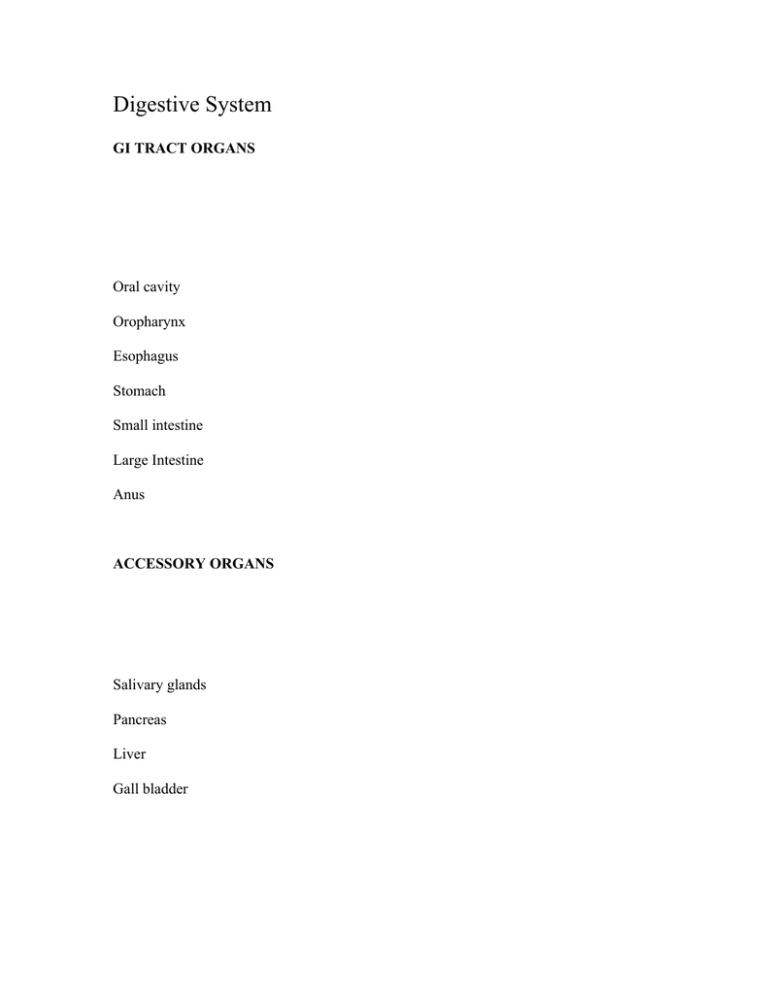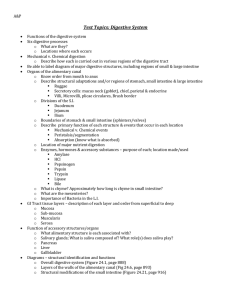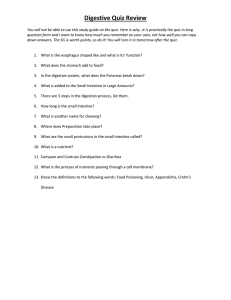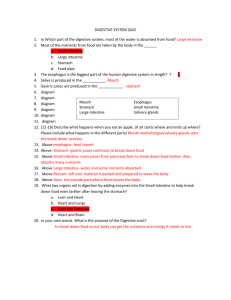Digestive System
advertisement

Digestive System GI TRACT ORGANS Oral cavity Oropharynx Esophagus Stomach Small intestine Large Intestine Anus ACCESSORY ORGANS Salivary glands Pancreas Liver Gall bladder GI TRACT LAYERS Mucosa Submucosa Submucosal plexus Muscularis externa Smooth muscle Myenteric plexus DIGESTIVE PROCESSES Ingestion Motility Peristalsis Segmentation Secretion Mucus HCl Bicarbonate Enzymes Hormones Digestion Carbohydrates Salivary amylase Pancreatic amylase Dextrinase Sucrase Maltase Lactase Lactose intolerance Proteins Peptidases Pepsin Trypsin Chymotrypsin Lipids Bile and lipid emulsification Breaking large fat gobules into smaller fat droplets Function of bile salts Salivary lipase Gastric lipase Pancreatic lipase Nucleic acids Nucleases Absorption Sublingual absorption of medicines Nitroglycerin Gastric absorption Aspirin Alcohol Absorption in Small Intestine Glucose, amino acids, vitamins and minerals are absorbed into capillaries Fatty acids etc. absorbed into lacteals Compaction Defecation DIGESTIVE REGULATION GI Regulation – sensors Mechanoreceptors are activated by distension of the digestive walls by food (bolus or chyme) Chemoreceptors activated by H+, proteins, and lipids in chyme Osmoreceptors are activated by amino acids and glucose GI Regulation sensory regulatory phases Cephalic phase Smell, taste or thought of food Gastric phase Stimuli arising in stomach Intestinal phase Stimuli arising in small intestine GI Regulation integration and output Autonomic nervous system Enteric nervous system Separate nervous system located within the GI wall Submucosal and Myenteric plexuses Influenced by autonomic system Gastrointestinal hormones Gastrin Cholecystokinin (CCK) Secretin Glucose dependent insulinotropic peptide (GIP) GI Regulation neural pathways Short pathway Receptor to intrinsic enteric plexuses out to effector Long pathway Receptor to CNS to effector GI Regulation – effectors Secretory cells within digestive organs Smooth muscles within digestive organs Muscle Activity or Motility Self generating graded potentials or slow waves Can produce action potentials Strength not rate of contractions Autonomic nerves and hormones DIGESTIVE ORGANS AND THEIR FUNCTIONS Oral Cavity and Salivary Glands • Mastication • Taste • Digestion of carbohydrates Salivary amylase Starch and glycogen Cephalic phase and chemoreceptors (taste buds) activate salivary secretion through parasympathetic stimulation Esophagus Muscular tube Upper esophageal sphincter Lower esophageal (cardiac) sphincter Acid reflux (heartburn) Swallowing Reflex Mechanoreceptors in oropharynx start the reflex Bolus presses on epiglottis closing off airways and preventing inspiration Upper esophageal sphincter opens Peristaltic contractions move bolus downward Lower esophageal sphincter opens Bolus enters stomach Stomach Anatomy Stomach – Functions • Secretion Mucus – lubrication Pepsinogen - pepsin Gastrin - hormone Intrinsic factor - vitamin B12 • Food separation – HCl • Digestion of proteins – pepsin • Mixes chyme – peristalsis • Storage of chyme • Delivers chyme to duodenum Gastric Regulation of Secretions Cephalic phase stimulates HCl, pepsinogen, and gastrin secretion Gastric phase Proteins and peptides in stomach activate chemoreceptors and mechanoreceptors and stimulate secretion Intestinal phase Chyme, lipids and H+ in duodenum activate mechanoreceptors, chemoreceptors, and osmoreceptors inhibit pepsinogen and acid secretion Gastric Regulation of Motility Cephalic phase stimulates motility Gastric phase Mechanoreceptors and chemoreceptors stimulate motility Gastrin stimulates motility Intestinal phase Mechanoreceptors, and chemoreceptors in duodenum inhibit motility CCK, secretin, and GIP inhibits motility Small Intestine – Anatomy Small Intestine – Functions • Digestion of food Pancreatic enzymes Intestinal mucosal enzymes • Absorption of nutrients • Secretion of hormones CCK, GIP and secretin • Entrance area for pancreas, liver and gall bladder secretions Pancreas Production of bicarbonate Buffer acids from stomach Production of digestive enzymes Peptidases Lipase Pancreatic amylase Nucleases Liver Bile production and secretion Gall bladder Bile storage, concentration and release Bile salts emulsify fats and lipids in small intestine Motility of Small Intestine Short periods of peristalsis Long periods of segmentation Distension of intestine triggers motility strength Gastrin promotes motility in ileum Large Intestine or Colon Anatomy Large Intestine – Functions • Absorption of minerals • Absorption of water and compaction of chyme into feces • Defecation Motility in Large Intestine Segmentation 2-3 times per hour Mass movement Strong peristaltic contractions 3-4 times per day Swift movement of chyme Gastrocolic reflex Peptic Ulcer







